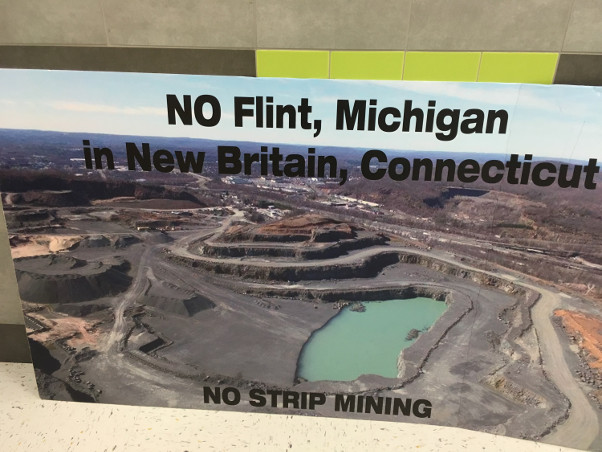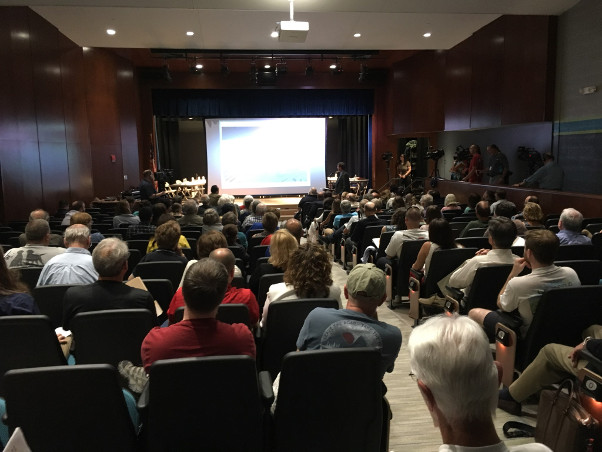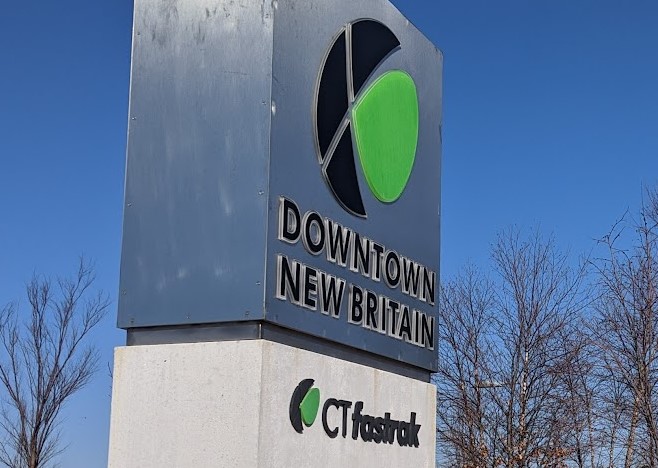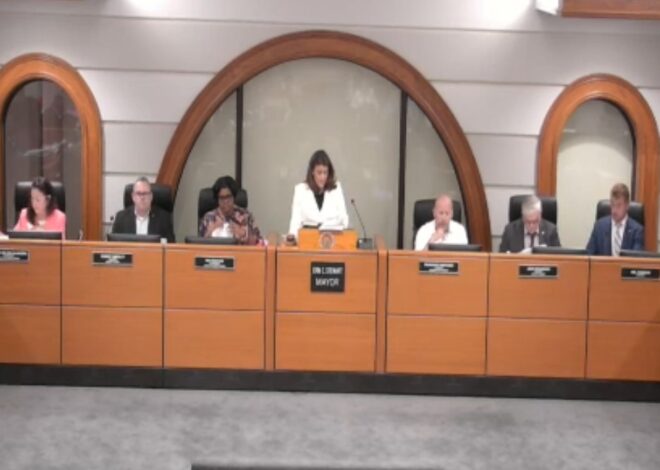Huge opposition met Republican Mayor Erin Stewart’s controversial plan to allow strip mining on New Britain drinking watershed land at the public hearing held on June 26, 2018 in front of the City Council and the Board of Water Commissioners.
Speaker after speaker spoke in opposition to the plan at a packed hearing in the auditorium at Gaffney Elementary School. Speaker after speaker in opposition to the plan was loudly applauded by the large crowd.

The public opposition at the hearing comes after reports from two key state commissions, the Water Planning Council and the Council on Environmental Quality, issued scathing criticisms of the report done for the Stewart administration by Lenard Engineering, that supported the need for new “storage reservoir” that would, under the proposal, be created by the strip mining of the city’s watershed land.
The state commissions’ reports raised concerns about the safety of drinking water, environmental damage and taxpayer costs as a result of the mining. The commissions also presented withering criticism of the claim that the new “storage reservoir” is even needed.
The watershed mining plans would involve removing a large section of a hill at an upstream part the watershed of New Britain’s primary drinking water reservoir, the Shuttle Meadow Reservoir. The proposal was earlier pressed for by Stewart’s father, Timothy Stewart, when he was mayor. Despite the elder Stewart’s strong support for the plans, the proposal was defeated.
On February 13, 2016, Erin Stewart began a public move to resurrect the plans of the elder Stewart to allow Tilcon to strip mine city drinking watershed land. According to Protect Our Watersheds CT, the younger Stewart had “…letters delivered into the mailboxes of residents near the Tilcon quarry about a ‘great new reservoir plan’…”.
Stewart has claimed on Twitter that, “I have not formed an opinion yet,” and that, “what this process is all about info gathering then to make a decision…”
But, in a February 17, 2016 article, the New Britain City Journal Stewart quoted Stewart as supporting the watershed strip mining plan, telling residents that blasting from current mining on Tilcon land, “is up to 300 feet from residents’ backyards. If this passes it will never again be that close.”
In that article, Stewart portrayed the watershed mining plan as a proposal to create a new reservoir, saying, “This is a no brainer to build another reservoir.” She also said, “In an effort to preserve a safe drinking water source for all future generations we would like to pursue this opportunity now.”
While Stewart, who is a candidate for the Republican nomination for Lieutenant Governor, has sought to maintain a public image of indecision on the widely unpopular watershed mining plan, she has consistently directed city resources toward promotion of the mining proposal.
Stewart committed over $350,000 of taxpayer funds to Lenard Engineering, leading to the study that presented underpinning of a case for mining of drinking watershed land as a way to create a new “storage reservoir” for the city.
And a month after the letters in which Stewart offered up the “great new reservoir plan” the city, under Stewart, was registered as having hired the lobbying firm of Gaffney, Bennett & Associates, the same lobbying firm that had been employed by the Tilcon company to lobby the state legislature. Tilcon would only be permitted to mine New Britain’s watershed land with the permission of the state legislature.
While Stewart has defended the plan to strip mine on New Britain’s drinking watershed land with the claim it would leave behind a new reservoir for the city, critics have said that plan is a dubious excuse for allowing the Tilcon company to mine the land.
The report from the two state commissions have validated those concerns, and many public comments at the June 26th hearing echoed points raised in these commissions’ findings.
The Water Planning Council (WPC) said “the WPC finds that the city’s report does not substantiate the need for the proposed new reservoir or, in fact, that the proposed reservoir would even be a viable public water storage facility. Based on this review, the WPC finds that the proposal’s risks to the current public water system and the environment are significant and the city’s report does not make a plausible case for undertaking such an activity and, therefore, does not justify the loss of forest and the ecological, recreational and environmental impacts.”
That commission also said that, “the WPC finds that preparation for quarrying, including clearcutting the forest and removing the stumps, soil and other natural material, followed by quarry operations, would eliminate much of the wild habitat of the site while creating the potential for decades of increased risk to the city’s nearby Shuttle Meadow Reservoir.”
The WPC found the alleged need for the proposed “storage reservoir” to be flawed. “The city’s report relies upon the confluence of a series of speculative and undocumented contingencies relative to both water demand and supply occurring in unison in order to justify the need for a new reservoir. The chance of all of these contingencies occurring is extremely remote. Therefore, the need for this 2.31 billion gallon storage reservoir has not been documented.”
The WPC also wrote that, “The city’s Water Supply Plan and the [Water Utility Coordinating Committee (WUCC)] Integrated Report show that the New Britain Water Department has excess water supply with respect to demand now and through the 50-year planning period, even using the increased demand projections provided by Lenard Engineering, without a new reservoir.”
The WPC raised concerns about the quality of New Britain’s drinking water that may result from the mining, saying that, “Much of the area that would be impacted in the proposed expanded area of quarrying is located in the active public drinking water supply watershed of the Shuttle Meadow Reservoir. Surficial activities associated with the quarrying operation, including clear-cutting the forest and removing the stumps, soil and other natural material could create a significant water quality risk to the reservoir.”
The WPC also noted, “that drainage from the construction sequence and incremental construction activities would occur in areas that would remain in the watershed draining to the Shuttle Meadow Reservoir. There would be a prolonged (decades-long) risk to reservoir water quality due to these activities in the existing drinking water watershed. There does not appear to be adequate analysis of this in the report.”
The WPC also raised concerns about the effect of the quality of city drinking water as a result of water coming from the proposed “storage reservoir”.
The WPC wrote that that Lenard report, “documents detectable concentrations of perchlorate in the surface water that currently exists at the quarry. The United States Environmental Protection Agency (EPA) has determined that perchlorate is a human health risk and has indicated this contaminant will be regulated in the future.”
The WPC added that, “TCE and 1,2,4-trichlorobenzene were detected in the raw water quality monitoring. TCE is a known human carcinogen and is a drinking water contaminant regulated by CT DPH and EPA under the SDWA. … There is a health risk associated with TCE and with 1,2,4-trichlorobenzene, which is also a regulated contaminant.”
The WPC also raised concerns that the depth of the proposed “storage reservoir”, 130 feet, may create conditions resulting in the metal, manganese, entering the water. The WPC said that, “The city’s report did not evaluate the potential for manganese to exceed water quality standards in the proposed reservoir. … Manganese is being studied by the EPA under the UCMR4 for possible future regulation in public drinking water.”

The Lenard report already conceded that that “storage reservoir” would not have enough land surrounding it to fill it, instead relying on water transported some distance from “flood-skimming” water from the Coppermine Brook.
The WPC, however, questioned Lenard’s analysis on behalf of the city of the drinking water quality of this “flood-skimming” water. “The city’s report only considered the water quality of Coppermine Brook under low or normal streamflow, not during the higher stream flow periods when flood-skimming would occur. Water quality is likely to be significantly different at that time. In particular, the water is likely to have very different levels of organic chemicals, inorganic chemicals, microorganisms including legionella, crypto, giardia, sediments and other organic matters that can get washed into the brook as rain water passes through the streets and the terrain of the Coppermine Brook watershed.”
The WPC raised the concern that, “This lower quality water will then be pumped to be stored in the proposed quarry reservoir and the subsequent residence period is conducive to the proliferation of a long list of contaminants, such as perchlorate or industrial solvents, that the existing treatment plant may not have the capacity to properly treat.”
The WPC also questioned the cost-effectiveness of filling the proposed “storage reservoir” with water transported from Coppermine Brook. “The report also does not analyze or discuss the costs of pumping such a large volume of water (2.31 billion gallons) from Coppermine Brook to the site to initially fill the reservoir or the future cost of pumping replacement water. The operational costs could be considerable.”
The environmental effects of the mining would be significant, according to the WPC. “There are multiple significant environmental issues and impacts which arise in connection with the proposed quarry/ reservoir. These fall chiefly within the categories of core forest impacts, vernal pool and wetland impacts, impacts to State-listed species, relocation of the Metacomet Trail and inconsistencies with the Connecticut Water Quality Standards.”
“Three State-listed species of special concern,” the WPC said, “namely the eastern box turtle, the spotted turtle and the Jefferson salamander, would be impacted by the development of this reservoir. In addition, four plant species currently known only from historic records may occur on this site, and one of these, last reported in Connecticut in 1879, was identified on the project site within the footprint of the reservoir.”
The WPC added that, “several other plant species may occur at the project site and should be surveyed for,” including Goldenseal (Hydrastis canadensis), Tall white bog orchid (Platanthera dilatada), Short-stalked false bindweed (Calystegia sylvatica).
The state’s Council on Environmental Quality (CEQ) also raised significant concerns about the mining plan. “It is the conclusion of the Council that the environmental consequences of the proposal would be adverse and that the need for the additional water storage capacity is not established in the report. Its assumptions about increased demand and reduced supply posit the worst extremes of each. The potential for reductions in demand is not fully considered.”
The CEQ wrote that, “The proposal that is the focus of the Report would replace a significant portion of a nearly 700 ft. high mountain with a 139 acre, 130 ft. deep reservoir. It would have no natural source other than rain water and ground water and would need to be filled primarily from stormwater runoff from other sources.”
“It would eliminate 13.6 acres of Class I watershed land and 111.9 acres of Class II watershed land that now contribute to New Britain’s West Canal and Shuttle Meadow Reservoir to allow for the operation of a commercial rock mining operation for an estimated period of forty years,” the CEQ added.
The CEQ said that new proposed reservoir, “If built, it would be the deepest lake entirely within Connecticut’s borders (130 feet). Concerns have been raised about water quality in the reservoir which would be filled primarily with surface storm water runoff (flood skimmed water), which is among the dirtiest of water sources and carries the risk of high treatment costs.”
The CEQ took special aim at the environmental consequences of the proposed strip mining. “The Report’s executive summary (Chapter 1) and its comparison of benefits versus environmental impacts (Chapter 13) understate important environmental consequences of the proposed project. Those consequences, which appear in other chapters of the Report, include loss of habitat for, or risk to, at least four species of special concern, three imperiled landscapes and displacement of a trail of regional significance. ”
The CEQ noted that the Lenard report, “makes clear that the impact for some of the resident flora and fauna is obliteration. Clearing and removing overburden on the proposed expansion area would eliminate entire habitats. The impact for other species, and for transient species, such as raptors and other migratory birds, would be diminished habitat.”
The CEQ criticized that, “Though the possibility of mitigation for some of the environmental damage is mentioned in the Report, specifics as to exactly what mitigation would occur and where it would be is absent, as is analysis of its likely success.”
The WPC pointed out that, if water storage capacity were, indeed, a priority for the city, other alternatives could be explored. “The report does not clearly indicate whether or not the water used to fill the quarry reservoir would otherwise be usable in an existing reservoir. … Although not mentioned in the city’s report, the nearby Plainville Reservoir was issued an abandonment permit in 1997. The report does not mention this water body or provide an analysis of its potential future reuse for water supply.”
Likewise, the CEQ wrote that, “Crescent Lake, a decommissioned reservoir, lies within sight of the proposed reservoir, though no mention is made of recommissioning it to supplement the City’s reserve. The potential of water conservation is not fully considered.”
The CEQ analysis also refers to potential opportunities for water conservation as a way ensure adequate water supply.
“Using the most conservative estimates for passive conservation,” the CEQ wrote, “there could be a decrease of 10 gallons per capita per day by 2040. An effort by the City of New Britain to reduce outdoor water use would reduce demand even further.”
The CEQ calls into question the fixing leaky pipes as a way to address water supply needs. “The Report does not factor in a reduction in unaccounted-for water. New Britain’s loss of potable water during transmission is about 25% higher than the norm.”
The CEQ says that the Lenard report, “shows an ever-increasing amount of water that is unaccounted for over the last five years. This five-year average is masking what appears to be an increasingly leak-prone water distribution system.”
With the June 26th public hearing complete, the Water Planning Council, in consultation with the Council on Environmental Quality, will prepare advice that will be submitted to the state legislature. Since the proposed mining on protected watershed land would require a special exception or change in state law, only the state legislature can decide to authorize it.
Editor’s Note: Video reporting by video journalist Antonio C. Lavoy, Sr. contributed to this article.




